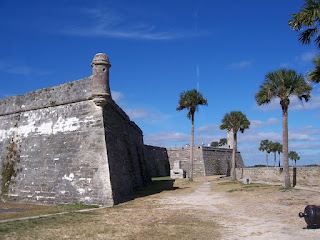Lena Zeldovich wrote:
In 1702, when the Spanish still ruled Florida, an English fleet from colonial Carolina approached Castillo de San Marcos, a Spanish stronghold on the Atlantic shore. . . .This behavior intrigued people who grew up near the fort, including mechanical engineering graduate student Phillip Jannotti and high-school student Sanika Subhash, daughter of Jannotti’s dissertation advisor.
But even after nearly two months of being shelled with cannonballs and gunfire, the fort’s walls wouldn’t give. In fact, they appeared to be “swallowing” the British cannonballs, which then became embedded within the stone. . . .
Built from coquina—sedimentary rock formed from compressed shells of dead marine organisms—the walls suffered little damage from the British onslaught. As one Englishman described it, the rock “will not splinter but will give way to cannon ball as though you would stick a knife into cheese.”
They formed a team that tested souvenir samples of coquina stone by firing small metal projectiles into the material and recording how it behaved with high-speed cameras.
The result:
coquina had a rare ability to absorb mechanical stress, which stemmed from its loosely connected inner structure. Although the little shell pieces that make up coquina are piled and pressed into each other for thousands of years, they aren’t cemented together, so they can shuffle around a bit.The Spanish thus practice-attacked their own fort, not worrying about weakening its walls. And it worked. Another British colonial force tried to take the fort again in 1740, also without success.
So when a cannonball slammed into the coquina walls of Castillo de San Marcos, it crushed the shells it directly hit, but the surrounding particles simply reshuffled to make space for the ball. “Coquina is very porous and its shells are weakly bonded together,” Jannotti says. “It acts almost as natural foam—the balls sink in, and slowly decelerate.”
It’s not clear whether the Spanish had known about coquina’s properties when they first built the walls, mining the stone from the nearby quarry within what is today Anastasia State Park. But they certainly learned to appreciate the material’s absorptive properties. When they realized coquina’s unique abilities, they used the fort walls for target practice.
Because of victories elsewhere, Britain held Florida from 1763 to 1783. During the Revolutionary War, therefore, this site was known as Fort St. Mark.

No comments:
Post a Comment